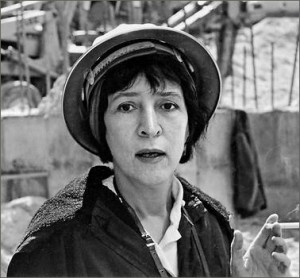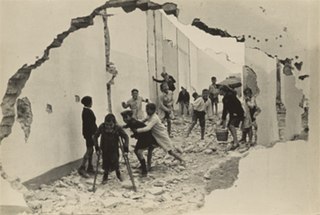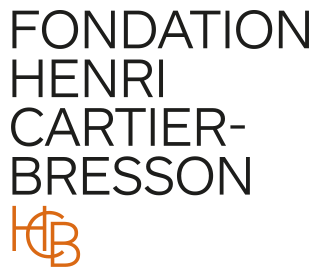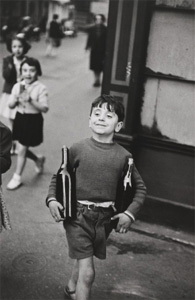
Gold Rush, Shanghai, also known by other titles like Gold Rush. The Last Days of Kuomintang, Shanghai, is a black and white photograph taken by Henri Cartier-Bresson in 1948. [1]

Gold Rush, Shanghai, also known by other titles like Gold Rush. The Last Days of Kuomintang, Shanghai, is a black and white photograph taken by Henri Cartier-Bresson in 1948. [1]
Cartier-Bresson went to China in December 1948, on assignment for Life magazine, initially for a short trip, but ended up staying for a much longer time, as he documented the historical events and the general environment as the Kuomintang government fell while the Chinese Communist Party was about to seize power and to proclaim what would become the People's Republic of China, in 1949. [2]
This is one of the most famous pictures out of the large amount that he took during this period. It was taken in Shanghai, on 23 December 1948, and documents what happened when the currency crashed and the Kuomintang decided to distribute 14 grams of gold by person. This resulted in thousands of people who waited in line to trade the gold for money, often suffocating to the point of death. [3]
The picture shows one of these events, it was entirely spontaneous, despite what might appear as a choreographed composition, and depicts a crowd of desperate customers, both men and women, pressing themselves as they try anxiously to reach the bank where they want to sell their gold. Cartier-Bresson waited carefully for the dramatic shape to take place and then captured it for posterity. [2] [4]
There are prints of this photograph at the Henri Cartier-Bresson Foundation, in Paris, the Museum Ludwig, in Cologne, and at the Metropolitan Museum of Art, in New York. [5] [3]

Henri Cartier-Bresson was a French artist and humanist photographer considered a master of candid photography, and an early user of 35mm film. He pioneered the genre of street photography, and viewed photography as capturing a decisive moment.

Street photography is photography conducted for art or inquiry that features unmediated chance encounters and random incidents within public places, usually with the aim of capturing images at a decisive or poignant moment by careful framing and timing. Although there is a difference between street and candid photography, it is usually subtle with most street photography being candid in nature and some candid photography being classifiable as street photography. Street photography does not necessitate the presence of a street or even the urban environment. Though people usually feature directly, street photography might be absent of people and can be of an object or environment where the image projects a decidedly human character in facsimile or aesthetic.

Helen Levitt was an American photographer and cinematographer. She was particularly noted for her street photography around New York City. David Levi Strauss described her as "the most celebrated and least known photographer of her time."

Martine Franck was a British-Belgian documentary and portrait photographer. She was a member of Magnum Photos for over 32 years. Franck was the second wife of Henri Cartier-Bresson and co-founder and president of the Henri Cartier-Bresson Foundation.
Raghubir Singh (1942–1999) was an Indian photographer, most known for his landscapes and documentary-style photographs of the people of India. He was a self-taught photographer who worked in India and lived in Paris, London and New York. During his career he worked with National Geographic Magazine, The New York Times, The New Yorker and Time. In the early 1970s, he was one of the first photographers to reinvent the use of color at a time when color photography was still a marginal art form.

Tseng Kwong Chi, known as Joseph Tseng prior to his professional career, was a Hong Kong-born American photographer who was active in the East Village art scene in the 1980s. He is the brother of dancer/choreographer Muna Tseng.
Fazal Sheikh is an artist who uses photographs to document people living in displaced and marginalized communities around the world.
Samuel Bejan Tata was a Chinese photographer and photojournalist of Parsi descent. Tata grew up in Shanghai where he learned the basics of photography from several mentors including Lang Jingshan and Liu Xucang. Due to political unrest, he mostly confined himself in his early career to portraiture in the tradition of pictorialism.
Humanist Photography, also known as the School of Humanist Photography, manifests the Enlightenment philosophical system in social documentary practice based on a perception of social change. It emerged in the mid-twentieth-century and is associated most strongly with Europe, particularly France, where the upheavals of the two world wars originated, though it was a worldwide movement. It can be distinguished from photojournalism, with which it forms a sub-class of reportage, as it is concerned more broadly with everyday human experience, to witness mannerisms and customs, than with newsworthy events, though practitioners are conscious of conveying particular conditions and social trends, often, but not exclusively, concentrating on the underclasses or those disadvantaged by conflict, economic hardship or prejudice. Humanist photography "affirms the idea of a universal underlying human nature". Jean Claude Gautrand describes humanist photography as:
a lyrical trend, warm, fervent, and responsive to the sufferings of humanity [which] began to assert itself during the 1950s in Europe, particularly in France ... photographers dreamed of a world of mutual succour and compassion, encapsulated ideally in a solicitous vision.
Peter Johnston Galassi is an American writer, curator, and art historian working in the field of photography. His principal fields are photography and nineteenth-century French art.

Behind the Gare Saint-Lazare is a black and white photograph taken by French photographer Henri Cartier-Bresson in Paris in 1932. The photograph has been printed at variable dimensions; the print donated by Cartier-Bresson to the Museum of Modern Art is listed at 35.2 × 24.1 cm. It is one of his best known and more critically acclaimed photographs and became iconic of his style that attempted to capture the decisive moment in photography. The photograph was considered one of the 100 most influential pictures of all time by Time magazine.

Hyères, France is a black and white photograph taken by Henri Cartier-Bresson in 1932. It is one of the photographs from the year when he started taking photography more professionally. He took then many pictures in France and in other countries, like Italy, Spain, Morocco and Mexico, with his portable Leica camera.

Seville, Spain is a black and white photograph taken by Henri Cartier-Bresson in 1933. He traveled through Spain in 1933, a trip which he documented with many pictures. He took this photograph in Seville, and was one of several that he captured in the same location.

Natcho Aguirre, Santa Clara, Mexico, is a black and white photograph taken by Henri Cartier-Bresson in 1934, while in a travel to Mexico.

The Henri Cartier-Bresson Foundation, also known as Fondation HCB, is an art gallery and non-profit organisation in Paris that was established to preserve and show the work of Henri Cartier-Bresson and Martine Franck, and show the work of others. It was set up in 2003 by the photographer and painter Cartier-Bresson, his wife, also a photographer, Franck, and their daughter, Mélanie Cartier-Bresson.

Rue Mouffetard, Paris, is a black and white photograph taken by Henri Cartier-Bresson in a Paris street in 1954.

Gestapo Informer Recognized by a Woman She Had Denounced, full title Gestapo Informer Recognized by a Woman She Had Denounced, Deportation Camp, Dessau, Germany, is a black and white photograph taken by Henri Cartier-Bresson in 1945. It is one of the most famous post-World War II pictures.

Juvisy, France, with the French title of Dimanche sur les Bords de Marne, Juvisy, is a black and white photograph taken by Henri Cartier-Bresson in 1938. The picture shows his influence and formation in painting and went to become one of his most known photographs.

Alberto Giacometti à la Galerie Maeght, Paris, France, 1961, or, in English, Alberto Giacometti at the Galerie Maeght, Paris, France, 1961, is a black and white photograph by French photographer Henri Cartier-Bresson, taken in 1961. The picture depicts his old friend of two decades, the Swiss sculptor Alberto Giacometti, as he appears to be setting up his own exhibition at the Galerie Maeght, in Paris.
Coronation of King George VI, London, England is a black and white photograph taken by French photographer Henri Cartier-Bresson, in 1937. Cartier-Bresson covered the coronation of King George VI, in London, on 12 May 1937, for the French Communist weekly Regards, focusing more on the people who were attending the official procession than in the event itself.